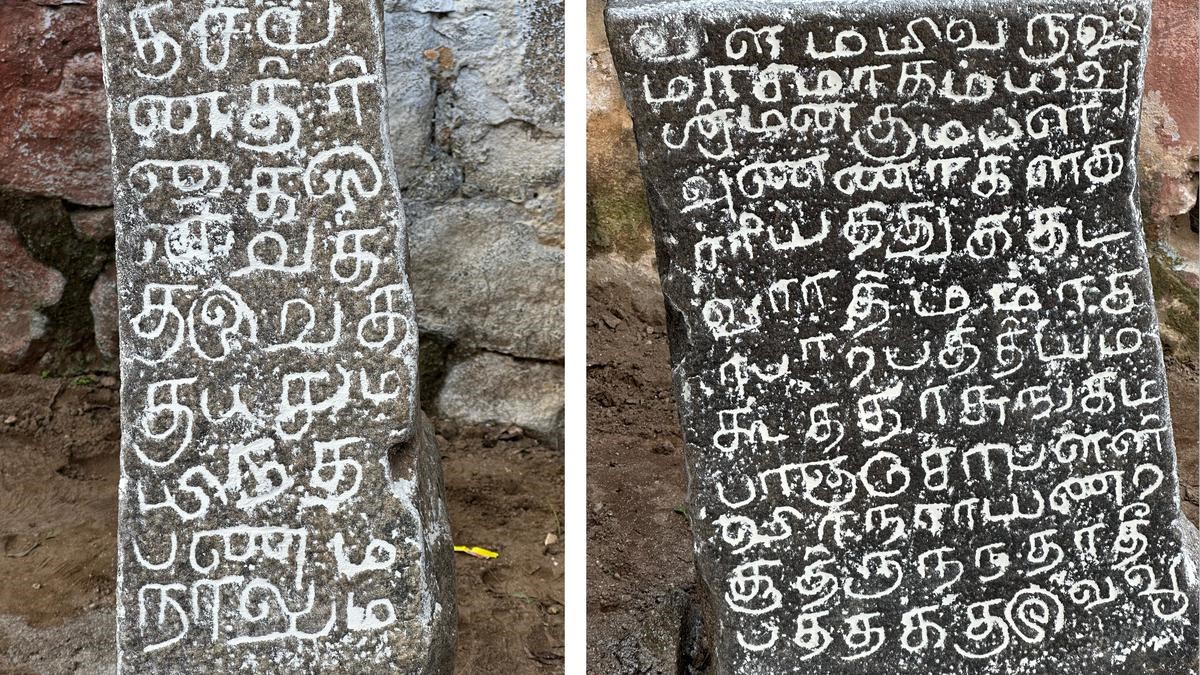Description

Disclaimer: Copyright infringement not intended.
Context
- A team from the Virarajendran Archaeological and Historical Research Centre in Tiruppur discovered two stone inscriptions at Lord Shiva and Lord Vishnu temples in Pazhnchervazhi village near Kangayam.
- The inscriptions date back to the 11th century (Grantham) and the 16th century (Tamil).
Details
11th Century Grantham Inscription
- The 11th-century Grantham inscription was found half-buried in front of the Amman shrine inside the Siva Temple.
- It features Graffiti marks and writings on all four sides, depicting symbols like standing lamps, 'trishul,' conch, and moon symbols.
- The inscription suggests the "manthra" stone was worshipped for curing diseases.
16th Century Tamil Inscription
- The 16th-century Tamil inscription was found half-buried inside the Vishnu temple.
- It contains descriptions in 12, nine, and four lines on three sides, providing historical insights into pottery-making during that period.
- The inscription mentions a potter named Kuthar Sungam making a donation of four rupees for lighting the perpetual lamp in the Vishnu temple, indicating the profitability of pottery-making during that time.
Historical Significance
- The Pazhanchervazhi village, previously known as ‘Pazhanhepali’ and ‘Pazhancherpalli,’ holds historical importance from the medieval period when Shaivism, Vaishnavism, and Jainism flourished.

Grantha Script
Origin and Relation to Other Scripts:
- The Grantha script originated from the Pallava script and is related to Tamil and Vatteluttu scripts.
- Modern Malayalam script in Kerala is a direct descendant of the Grantha script.
- Southeast Asian and Indonesian scripts, such as Thai and Javanese, and South Asian scripts like Tigalari and Sinhala, are derived or closely related to Grantha through the early Pallava script.
Historical Development:
- The Pallava script, also known as Pallava Grantha, emerged in the 4th century CE and was used until the 7th century CE in India.
- Early Grantha script was used for writing Sanskrit texts, inscriptions on copper plates, and stones of Hindu temples and monasteries.
- It was employed for classical Manipravalam, a language blending Sanskrit and Tamil.
- Middle Grantha evolved by the 7th century, and Transitional Grantha emerged around the 8th century, remaining in use until about the 14th century.
- Modern Grantha has been in use since the 14th century for writing classical texts in Sanskrit and Dravidian languages, as well as for chanting hymns and in traditional Vedic schools.
Purist Movement and Tamil Nationalism:
- The Tamil purist movement during the colonial era aimed to eliminate the use of the Grantha script and promote the Tamil script exclusively.
- Scholars like Kailasapathy view this as part of Tamil nationalism and regional ethnic chauvinism.
Manipravalam Writing System:
- Grantha script was historically used for writing Manipravalam, a blend of Tamil and Sanskrit.
- Manipravalam texts required Tamil words to be written in the Tamil script and Sanskrit words in the Grantha script.
- This system evolved to the point that both scripts could be used within the same word, depending on the language origin of its components.
Usage in Modern Times:
- In contemporary times, the Tamil-Grantha script is used in religious contexts by Tamil-speaking Hindus.
- It is employed during naming ceremonies, for the Sanskrit portion of traditional wedding cards, and in announcements of a person's last rites.
- The script is also used in religious almanacs to print traditional formulaic summaries of the coming year in many Hindu communities.

Conclusion
This discovery adds to the understanding of the region's history and cultural practices, shedding light on religious and economic activities during the 11th and 16th centuries. The Grantha script has a rich history, having played a crucial role in the preservation and dissemination of Sanskrit and classical Dravidian languages. Despite historical transitions and shifts in usage, it continues to be employed in specific cultural and religious contexts.
|
PRACTICE QUESTION
Q. Examine the challenges faced by the Grantha script during the colonial era and its contemporary usage in religious and cultural contexts among Tamil-speaking Hindus. (250 Words)
|







